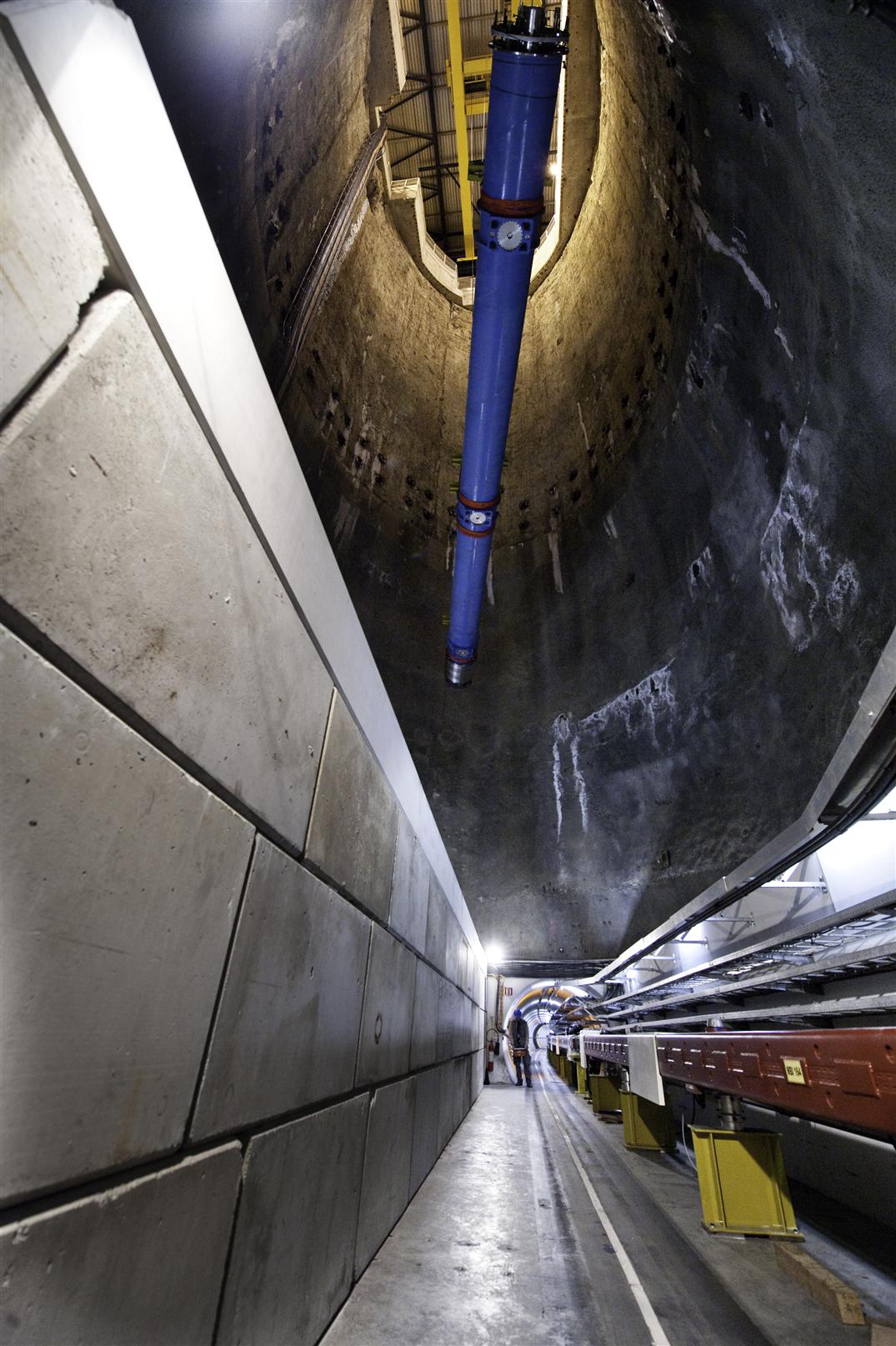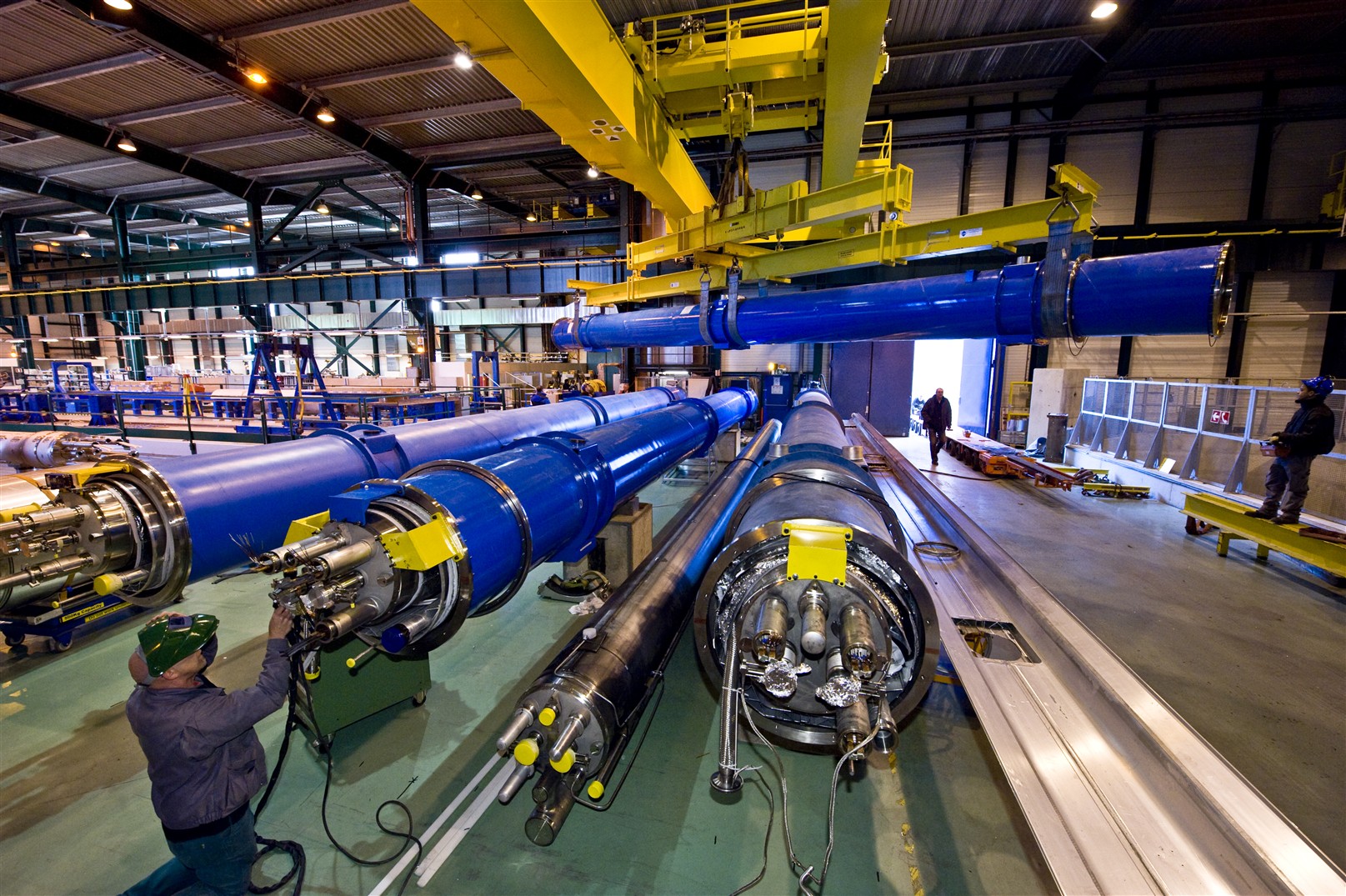Mobilizing for the LHC
A follow-up report on the incident that occurred in LHC Sector 3-4 was published on 5 December. It confirms that the accelerator will be restarted in the summer of 2009. From now until then, the teams will be pulling out all the stops to repair the sector and enhance the operational safety of the machine.
A dipole magnet being raised to the surface through the PMI2 shaft in order to be repaired. These transport activities are taking place during the evening or at night to avoid disturbing the other operations taking place underground.
The pace of repairs is hotting up in Sector 3-4. As the repair operations cover many fields, they involve a large number of experts from various departments. Hall SM12, which sits over the access shaft used for magnet lifting operations to and from the tunnel, is a veritable hive of activity. The logistics problem is a particularly thorny one: it is essential that heavy-handling activities to bring magnets up from the tunnel at the rate of two per day do not interfere with the operations of the teams working underground. A total of 53 magnets will be brought back to the surface before the end-of-year closure. In parallel, the spare magnets have been prepared and tested and are starting to be lowered into the tunnel.
Hall SM12, which sits over the access shaft for dipole magnets, is full of magnets ready to go underground and those that have already been brought up from the tunnel.
Over a hundred people are now actively involved in the operations, underlining the strong sense of motivation to get the job done. "The team spirit is fantastic and we have experienced strong support throughout CERN," underlines Jean-Philippe Tock (AT/MCS), who is in charge of the interconnections. "We have received offers of help from many CERN people."
The first stage of the repair programme is to inspect all the magnets underground and then at the surface. Virtually all the cold masses of the 57 magnets affected seem to be intact. The damage has been to the components located between the cryostat and the cold masses. About ten of the magnets have not been damaged at all and will just be cleaned. In other cases, where the multi-layer thermal insulation blankets around the cold masses, and the cold supports on which the cold masses sit in the cryostat, have been damaged, the repairs are more substantial. In such cases, the cold mass has to be extracted from its cryostat and, depending on the degree of damage, components are salvaged to be used as spare parts or the damaged components are replaced before the cold mass is re-inserted into its cryostat. This work is being carried out directly in Hall SMI2, where the cryostat facility is based. "In collaboration with our colleagues from TS Department, last week we set up a second assembly bench in Hall 180 in order to increase the pace of assembly work for the Sector 3-4 dipoles," underlines Vittorio Parma (AT/MCS), who is in charge of the cryostats. "We made sure that we have enough spare parts to carry out all the repairs."
The short straight sections containing the quadrupoles are being assembled in parallel at the Prévessin site. Another important aspect of the repair work is the inspection of the beam pipes and screens for contamination by soot-like metal dust and debris from the damaged insulation blankets. All the affected sections of beam pipe and the beam screens are being inspected and cleaned if necessary.
To enhance operational safety, priority has been given to replacing the magnets in Sector 3-4 with spares. Thus, 30 spare dipole magnets and nine spare short straight sections will be installed. However, all the magnets destined for the tunnel are undergoing complete warm and cold testing in Hall SM18. "We are testing up to three magnets per week", explains Louis Walckiers, AT/MEI group leader, who is in charge of the magnet testing. "At the beginning of February, we will have more cryogenic capacity for these tests."
The magnets are all tested up to 12’850 A, which corresponds to a field of 9 Tesla, above the 8.3 Tesla specified for nominal operation of the LHC at 7 TeV. Additional tests have been introduced.
From January, the tested magnets will be going down into the tunnel at a faster rate. "The goal is to have all the magnets in place in the tunnel by the end of March", explains Francesco Bertinelli (AT/MCS), who is responsible for planning and coordination. The interconnections will start at the beginning of February with what Jean-Philippe Tock (AT/MCS) refers to as "enhanced quality control". The final stage will be the testing of the entire sector in June and July. In parallel, new electronics aimed at enhancing operational safety of the machine (see box) will be installed.
These operations, which are long and complex but necessary to ensure the operational safety of the LHC, explain why the accelerator cannot restart until next summer.
Enhanced operational safety of the machine
The detailed report has confirmed that a small resistive zone developing in a bus connection of the circuit that conducts current from one magnet to the next was probably the cause of the incident. The resistance was very small - 200 nano-ohms, dissipating of the order of 10 W at high current intensity! "However, the maximum resistance specified for these interconnections is 0.6 nano-ohms", underlines Jean-Philippe Tock (AT/MCS), who is in charge of the interconnections.
All the circuits of the main magnets are currently undergoing power tests to detect any abnormal resistances. As a result of this inspection, a magnet in Sector 1-2 will also be replaced.
To avoid any recurrence of such an incident, new electronic boards will protect the magnets by constantly measuring the resistance of the busbars and the interconnections. These new additional electronics will also measure other parameters. "We have launched manufacture of 6500 electronic boards which will be integrated into 450 crates underneath the magnets," explains Knud Dahlerup-Petersen (AT/MEI), who is responsible for the electrical protection systems for the LHC. "We will start installation at the beginning of April, but cable installation will begin in January." In fact almost 200 km of cable will have to be laid.
Other measures will also be taken to enhance the operational safety of the machine.
More information can be found in the
detailed report on the incident.



